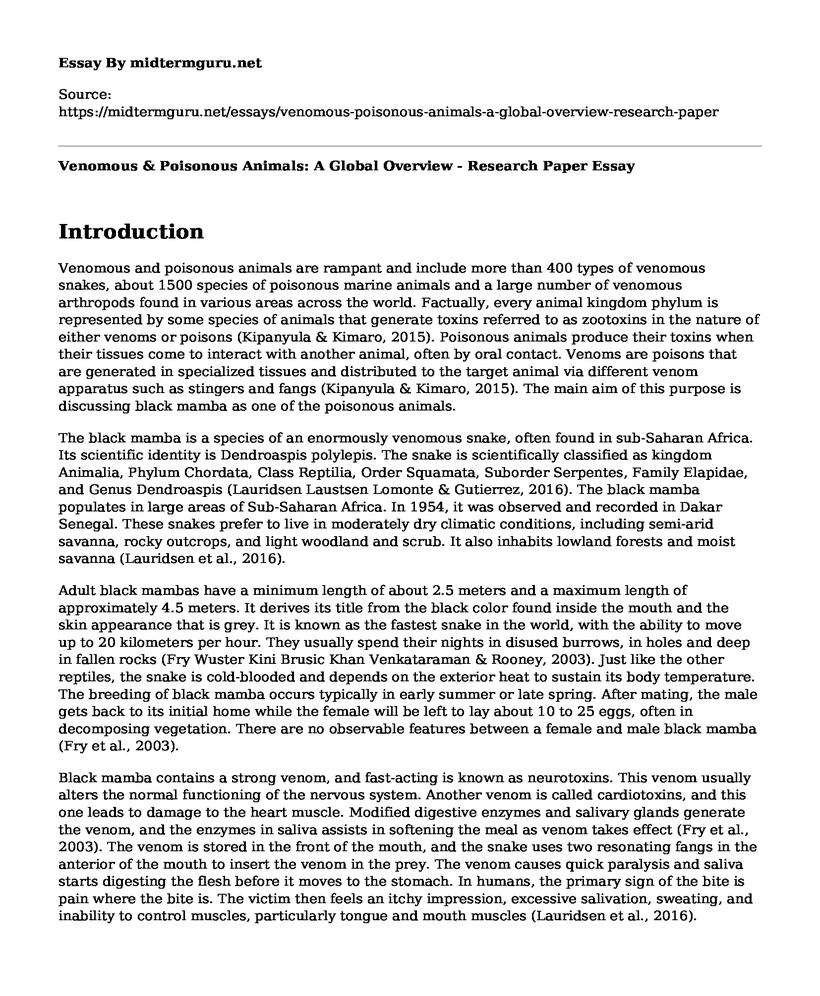Introduction
Venomous and poisonous animals are rampant and include more than 400 types of venomous snakes, about 1500 species of poisonous marine animals and a large number of venomous arthropods found in various areas across the world. Factually, every animal kingdom phylum is represented by some species of animals that generate toxins referred to as zootoxins in the nature of either venoms or poisons (Kipanyula & Kimaro, 2015). Poisonous animals produce their toxins when their tissues come to interact with another animal, often by oral contact. Venoms are poisons that are generated in specialized tissues and distributed to the target animal via different venom apparatus such as stingers and fangs (Kipanyula & Kimaro, 2015). The main aim of this purpose is discussing black mamba as one of the poisonous animals.
The black mamba is a species of an enormously venomous snake, often found in sub-Saharan Africa. Its scientific identity is Dendroaspis polylepis. The snake is scientifically classified as kingdom Animalia, Phylum Chordata, Class Reptilia, Order Squamata, Suborder Serpentes, Family Elapidae, and Genus Dendroaspis (Lauridsen Laustsen Lomonte & Gutierrez, 2016). The black mamba populates in large areas of Sub-Saharan Africa. In 1954, it was observed and recorded in Dakar Senegal. These snakes prefer to live in moderately dry climatic conditions, including semi-arid savanna, rocky outcrops, and light woodland and scrub. It also inhabits lowland forests and moist savanna (Lauridsen et al., 2016).
Adult black mambas have a minimum length of about 2.5 meters and a maximum length of approximately 4.5 meters. It derives its title from the black color found inside the mouth and the skin appearance that is grey. It is known as the fastest snake in the world, with the ability to move up to 20 kilometers per hour. They usually spend their nights in disused burrows, in holes and deep in fallen rocks (Fry Wuster Kini Brusic Khan Venkataraman & Rooney, 2003). Just like the other reptiles, the snake is cold-blooded and depends on the exterior heat to sustain its body temperature. The breeding of black mamba occurs typically in early summer or late spring. After mating, the male gets back to its initial home while the female will be left to lay about 10 to 25 eggs, often in decomposing vegetation. There are no observable features between a female and male black mamba (Fry et al., 2003).
Black mamba contains a strong venom, and fast-acting is known as neurotoxins. This venom usually alters the normal functioning of the nervous system. Another venom is called cardiotoxins, and this one leads to damage to the heart muscle. Modified digestive enzymes and salivary glands generate the venom, and the enzymes in saliva assists in softening the meal as venom takes effect (Fry et al., 2003). The venom is stored in the front of the mouth, and the snake uses two resonating fangs in the anterior of the mouth to insert the venom in the prey. The venom causes quick paralysis and saliva starts digesting the flesh before it moves to the stomach. In humans, the primary sign of the bite is pain where the bite is. The victim then feels an itchy impression, excessive salivation, sweating, and inability to control muscles, particularly tongue and mouth muscles (Lauridsen et al., 2016).
Black mamba also attacks other organisms like birds, mouse, and insects. When attacking small animals like the mouse, it delivers a deadly bite and then withdrawals for the neurotoxin to paralyze it. When attacking a bird, the snake will grip at it preventing it from escaping. It is also capable of holding up their heads to about one meter above the ground to catch insects (Lauridsen et al., 2016).
References
Fry, B. G., Wuster, W., Kini, R. M., Brusic, V., Khan, A., Venkataraman, D., & Rooney, A. P. (2003). Molecular evolution and phylogeny of elapid snake venom three-finger toxins. Journal of molecular evolution, 57(1), 110-129. Retrieved from https://link.springer.com/article/10.1007/s00239-003-2461-2
Kipanyula, M. J., & Kimaro, W. H. (2015). Snakes and snakebite envenoming in Northern Tanzania: a neglected tropical health problem. Journal of venomous animals and toxins including tropical diseases, 21(1), 32. Retrieved from https://jvat.biomedcentral.com/articles/10.1186/s40409-015-0033-8
Lauridsen, L. P., Laustsen, A. H., Lomonte, B., & Gutierrez, J. M. (2016). Toxicovenomics and antivenom profiling of the Eastern green mamba snake (Dendroaspis angusticeps). Journal of proteomics, 136, 248-261. Retrieved from https://www.sciencedirect.com/science/article/pii/S1874391916300264
Cite this page
Venomous & Poisonous Animals: A Global Overview - Research Paper. (2023, Feb 05). Retrieved from https://midtermguru.com/essays/venomous-poisonous-animals-a-global-overview-research-paper
If you are the original author of this essay and no longer wish to have it published on the midtermguru.com website, please click below to request its removal:
- Essay on Water Pollution in the USA
- Consequence Management - Paper Example
- Effects of Mountaintop Coal Mining and the Deepwater Horizon Oil Spill - Paper Example
- Paris Climate Deal: Uniting Nations to Combat Climate Change - Essay Sample
- Carlton Watkins: Instrumental in Advocating for Environmentalism - Essay Sample
- Paper Example on Darwin's Theory of Evolution
- A Woman With A 24-Hours Memory - Essay Sample







